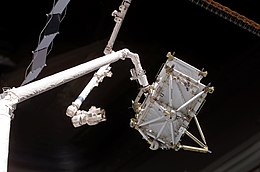
Back STS-116 Arabic STS-116 Bulgarian STS-116 Catalan STS-116 Czech STS-116 Danish STS-116 German STS-116 Greek STS-116 Spanish STS-116 Estonian استیاس-۱۱۶ Persian
 Discovery's Canadarm hands the P5 truss segment to Canadarm2, prior to its installation on the ISS. | |
| Names | Space Transportation System-116 |
|---|---|
| Mission type | ISS assembly |
| Operator | NASA |
| COSPAR ID | 2006-055A |
| SATCAT no. | 29647 |
| Mission duration | 12 days, 20 hours, 44 minutes, 16 seconds |
| Distance travelled | 8,500,000 kilometres (5,300,000 mi) |
| Spacecraft properties | |
| Spacecraft | Space Shuttle Discovery |
| Launch mass | 120,413 kilograms (265,466 lb)[1] |
| Landing mass | 102,220 kilograms (225,350 lb)[1] |
| Crew | |
| Crew size | 7 |
| Members | |
| Launching | |
| Landing | |
| Start of mission | |
| Launch date | December 10, 2006, 01:47:35 UTC |
| Launch site | Kennedy, LC-39B |
| End of mission | |
| Landing date | December 22, 2006, 22:32:00 UTC |
| Landing site | Kennedy, SLF Runway 15 |
| Orbital parameters | |
| Reference system | Geocentric |
| Regime | Low Earth |
| Perigee altitude | 326[2] |
| Apogee altitude | 358[2] |
| Inclination | 51.6 degrees[2][3] |
| Period | 91.37 minutes[2] |
| Epoch | December 12, 2006[2] |
| Docking with ISS | |
| Docking port | PMA-2 (Destiny forward) |
| Docking date | December 11, 2006, 22:12 UTC |
| Undocking date | December 19, 2006, 22:10 UTC |
| Time docked | 7 days, 23 hours, 58 minutes |

 Back (L-R): Curbeam, Patrick, Williams, Fuglesang Front (L-R): Oefelein, Higginbotham, Polansky | |
STS-116 was a Space Shuttle mission to the International Space Station (ISS) flown by Space Shuttle Discovery. Discovery lifted off on December 9, 2006, at 20:47:35 EST. A previous launch attempt on December 7 had been canceled due to cloud cover. It was the first night launch of a Space Shuttle since STS-113 in November 2002.[4]
The mission is also referred to as ISS-12A.1 by the ISS program. The main goals of the mission were delivery and attachment of the International Space Station's P5 truss segment, a major rewiring of the station's power system, and exchange of ISS Expedition 14 personnel. The shuttle landed at 17:32 EST on December 22, 2006, at Kennedy Space Center 98 minutes off schedule due to unfavorable weather conditions. This mission was particularly notable to Sweden, being the first spaceflight of a Scandinavian astronaut (Christer Fuglesang).
STS-116 was the final scheduled Space Shuttle launch from Pad 39B as NASA reconfigured it for Ares I launches.[5] The only remaining use of Pad 39B by the shuttle was as a reserve for the STS-400 Launch on Need mission to rescue the crew of STS-125, the final Hubble Space Telescope servicing mission, if their shuttle became damaged.[6]
After STS-116, Discovery entered a period of maintenance. Its next mission would be STS-120 starting on October 23, 2007.
- ^ a b "STS-116 Press Kit" (PDF). NASA. Archived (PDF) from the original on August 31, 2021. Retrieved August 16, 2015.
- ^ a b c d e McDowell, Jonathan. "Satellite Catalog". Jonathan's Space Page. Archived from the original on October 18, 2018. Retrieved May 28, 2013.
- ^ Harwood, William (December 8, 2006). "Quick-Look Mission Facts and Figures". Spaceflight Now. Archived from the original on December 10, 2006. Retrieved November 27, 2006.
- ^ Than, Ker; Malik, Tarig (December 7, 2006). "Night Launch: Shuttle Discovery Set for Evening Space Shot". SPACE.com. Archived from the original on May 23, 2009. Retrieved December 19, 2006.
- ^ Horowitz, Scott "Doc". "Development and operation" (PDF). NASA. Archived from the original (PDF) on January 13, 2010. Retrieved January 22, 2010.
- ^ Bergin, Chris (November 19, 2006). "NASA details Ares launch pad timeline". nasaspaceflight.com. Archived from the original on May 12, 2009. Retrieved March 9, 2010.
© MMXXIII Rich X Search. We shall prevail. All rights reserved. Rich X Search